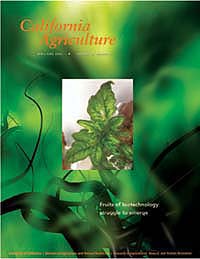All Issues
Letters
Publication Information
California Agriculture 58(3):132-132.
Published July 01, 2004
PDF | Citation | Permissions
Full text
WHAT DO YOU THINK?
The editorial staff of California Agriculture welcomes your letters, comments and suggestions. Please write to us at calag@ucop.edu or 1111 Franklin St., 6th fl., Oakland, CA 94607. Include your full name and address. Letters may be edited for space and clarity.
High-quality social analysis
I enjoyed reading “Horticultural biotechnology faces significant economic and market barriers,” in April-June 2004 California Agriculture. Author Julian Alston deals with the behavior of people and their institutions in a way that is analogous to how I deal with plants' regulatory pathways. It is an interesting contrast in that among physiologists like me and many other plant scientists, the subject quickly becomes a blame-fest accusing various players of being stupid, dishonest, selfish or greedy. In contrast, the article approaches all of these people factors as behaving just as neutrally as plant pathways. They just do what they do, and these are the consequences. At the end, some reasonable predictions are made about which changes in the system would result in greater adoption of horticultural biotechnology.
How does one get biologists to apply their honed skills at unprejudiced analysis to human systems? Since this analysis is familiar in its scientific approach but differs in subject matter, it provides the best teaching tool I have seen for raising the quality of social analysis by biological scientists dealing with horticultural biotechnology.
Björkman Thomas
Associate Professor of Vegetable Crop Physiology Cornell University Biochemistry, UC Davis, 1980
Outstanding review
Thank you for publishing the outstanding review of horticultural biotechnology in your latest issue of California Agriculture. It is packed with well-written articles and useful information.
Daniel Pollak
California Research Bureau Sacramento
Ecological risks ignored
I am appalled by your recent issue (April-June 2004) on biotechnology. There is not one article on the potential ecological risks of genetically modified organisms (GMOs). In my opinion this is a disservice to the farmers and consumers of California, as your magazine provides a one-sided view on an important issue. I challenge you to consider inviting a paper on the risks of this technology and the alternatives available.
Miguel A. Altieri
Professor of Agroecology UC Berkeley
Editor's response: We are already at work on a special section devoted to the risks and benefits of agricultural biotechnology (see the Editor's note at the top of the first text page of the April-June 2004 issue). The peer-reviewed manuscripts of that issue examined the hurdles to horticultural biotechnology only. In our judgment, a careful examination of risks and benefits also merits a special section.





